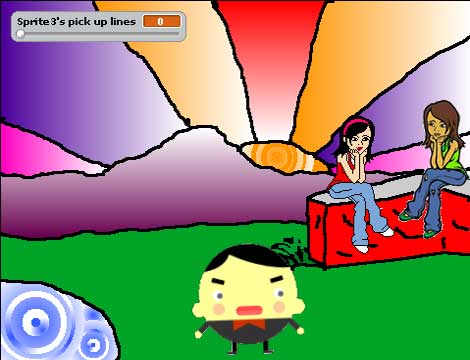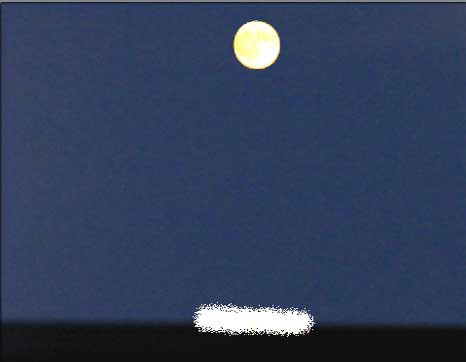Session Three
We started with Chris’s game, Swimmin Hole, where you use the arrow keys to move your character back and forth and press number keys to try pick up lines on the girls.

While he had trouble getting his own audio imported and had to use stock files, he was happy he was able to get the character to “jump” into the water (with a splash fx and hide command). His intent was to make people laugh with this and he succeeded. He used a combo of stock and handdrawn graphics to create a very colourful and engaging visual.
Next up was Marc’s mod of the Pong game that came with the Scratch installation.

He replaced the graphics with ones from a photograph of the night sky, using the moon as the ball, speeding it up and adding a beatbox that looped upon hitting the paddle. It was an enjoyable mod, although the moon-as-ball was not immediately noticeable.
Jim also modded the existing Pong game into Space Interference: “Use the mouse to keep your Space Warrior relaunching on the Space Launcher and preventing it from falling into the Space Lava. To defeat your Space Enemy, you must press the mouse button to deploy your blue Space Interference until the Space Metre has reached 200. However, the Space Interference also affects your Space Launcher. THEREIN LIES THE RUB”
People seemed to enjoy playing it once they had understood what the object was. It could be a bit simpler, and Jim explained that it was chiefly inspired by using the “pen” function in Scratch that had driven the development.
That was followed by a discussion of the advantages/disadvantages of “high concept” games like Chris’, where he had an idea and tried to realize it, versus Jim’s style of fooling around with a feature and trying to come up with a game dynamic to make it interesting. (Chris started with a blank page and filled it; Jim started with a block of stone and whittled away.) Chris commented that his imagination often exceeds his ability in these situation, where Jim wondered if his approach was too technology driven.
Next Jim and Marc did a show and tell postmortem of Feng Shui Master, a game they tried and failed to make between 2000-2003. They showed a Flash mockup Marc had made and discussed the two different programmers who had committed to, worked on, and then left the project mysteriously. Jim had a theory that not many programmers mixed with artists, and those that did were liable to mix with a lot of different people: so many so perhaps that that subset took on more projects than they could manage. Regardless, although it was frustrating he felt it was a good experience to write a design document and learn about the importance of asking for the code thus far. Also, in the end, Jim and Marc felt that while it was a fun concept (“optimize the feng shui in a room to move to the next room”) it probably wouldn’t have made a very playable or fun game.
Jim then did a few demos of some game creation tools that seemed suitable for the projects that people had mentioned wanting to work on. Power Game Factory seemed especially good for Chris as it was specifically for creating 2D sidescrollers for the Mac. Marc said he thought he’d stick with Scratch, since he liked its potential for simple arcade style games. Emily was absent, so the discussion of LassieAS, Wintermute, the Adventure Game Studio and Visionaire — all tools for creating point-and-click Sierra style adventure games — will be left until next session.
Next week’s assignment is to create the beginning of a more ambitious game with one of the game creation tools.
You must be logged in to post a comment.


Leave a Reply